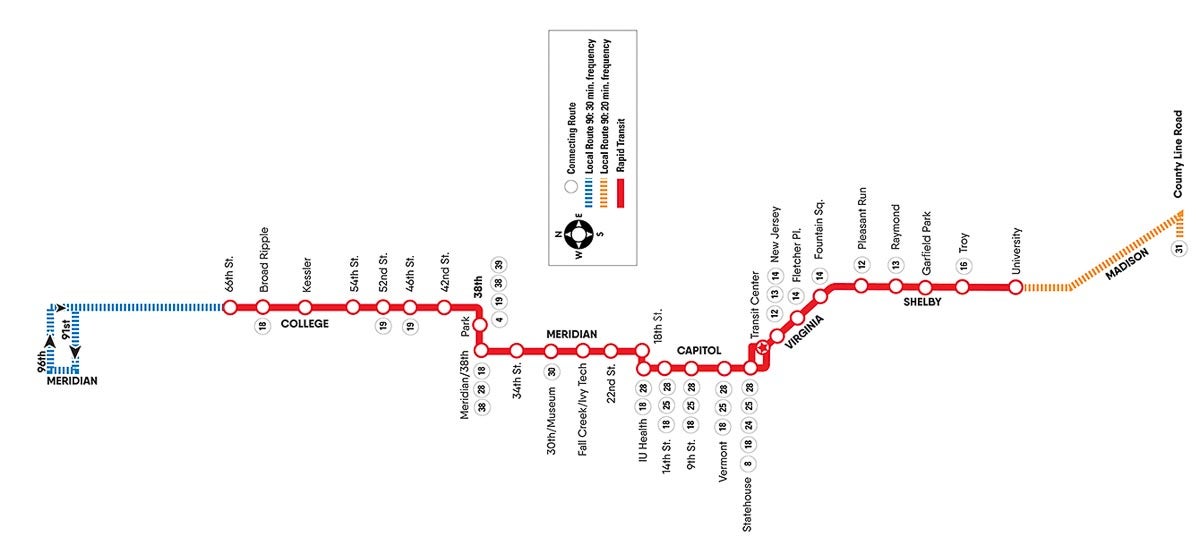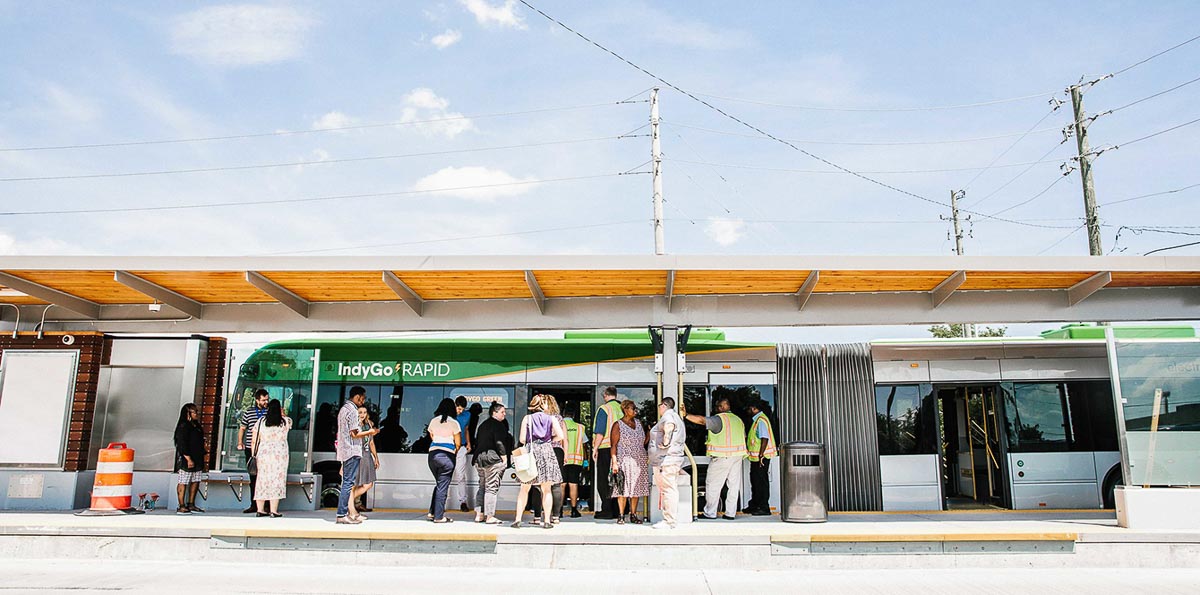To help readers better understand the bus rapid transit (BRT) approach, Urban Edge is running a series of posts from transit experts exploring what BRT will mean for the future of the transportation system in the Houston metropolitan area. In the fourth and final part of the series, IndyGo representatives detail the implementation of the Red Line BRT route, which connects universities, job centers, downtown, residential neighborhoods and a major medical center in Indianapolis.
A first since the age of the streetcar, IndyGo’s Red Line Bus Rapid Transit (BRT) line elevated transit service for the city of Indianapolis.
Opening Sept. 1, 2019, to high ridership and crowded platforms, the Red Line was the first rapid transit experience for many current and past riders. The Red Line travels 13 miles through the heart of a 400-square-mile county connecting universities, major centers of employment, a busy downtown, residential neighborhoods, and a major medical center. It is the energizing spine to a full make-over of a system that has seen historic disinvestment, declining ridership and service reductions.
Read Part 1 of the BRT series, written by Kyle Shelton, deputy director of the Kinder Institute for Urban Research; Part 2, from transit advocate and expert Christof Spieler; and Part 3, from Metro Transit in the Twin Cities.
Indianapolis chose BRT as our mode because it allowed us to provide the same level of service as light rail while making our limited funds go further. For 20 years prior to 2010, transit planning revolved around a single light rail line along a congested suburban corridor — and new funding to build it was going nowhere. We made a strategic decision to pivot to a holistic system approach to provide benefits to most of the city to get a wider base of support — for the same money it would have taken to build that light rail line we will be able to put in over 55 miles of high-quality BRT.
After more than a decade of research, advocacy and education, a transit tax referendum was passed by voters in 2016. Ratified by the governing city-county council in 2017, the 0.25% income tax is dedicated solely to transportation projects and changed the course for the transit agency. Over the next five years, Indianapolis’ current and future riders will see a 70% increase in overall transit service. While this includes the Red Line BRT, the core investment is in a frequent and reliable grid network moving people to and from three BRT lines.
The Red Line is the city’s boldest mobility infrastructure project in generations. Riders board and alight from level station platforms that were inspired by an international design competition. Off-board fare collection, transit signal prioritization (TSP) and bus-only lanes for 60% of the route allow the bus to be a truly competitive option to cars and arrive reliably at stations every 10 – 15 minutes.

The Red Line connects universities, major centers of employment, a busy downtown, residential neighborhoods and a major medical center.
Source: IndyGo
First all-electric BRT in the U.S.
The Red Line also has extensively used some unique concepts to minimize costs and enhance service. It is the first all-electric BRT system in the country, using 60-foot articulated battery-powered buses that are smooth, quiet and emit no local emissions. It uses mostly center-platform stations, which give a rail-like feel as well as minimize the costs of duplicating structures and electronics. Finally, a contra-flow lane provides two-way transit service on an otherwise one-way street, and a bi-directional lane through one portion makes it possible to fit both directions of bus travel through a tight corridor in a single lane.
Incessant public education and communication is critical as well as ensuring operators and dispatch are well-trained on procedure and expectations prior to opening. Public affairs leadership attended construction update meetings and distributed weekly three-week look-ahead emails and notices to all outlets. During opening week, more than 200 public volunteers were available to answer questions and share in the excitement at the Red Line stations.
Ongoing education and one-on-one meetings help neighborhoods and leadership understand the complexities of the constructing the Red Line, build and maintain goodwill and, ultimately, establish long-term support.
Building in adequate training time on the completed line is essential. Tight timelines in Indianapolis prevented additional training on the full line aside from seven days before opening. Training time is also essential for the dispatch team managing the bus spacing and communicating directly with the operators on the route. This continues to be an ongoing learning opportunity for the IndyGo team.
Bus-only lanes, level boarding and TSP should be advocated for intently. This is a win for the IndyGo Red Line and should be a priority for rapid transit and local bus routes, where possible. Opening up the space for shared-mobility exclusively, builds trust in the investment and service that in turn opens up lifestyle and pattern opportunities. When planning and designing, work with partners to ensure as much of the travel route is engineered for transit’s benefit.
Even while the weather cools and daylight wanes, the line continues to see steady daily ridership, and testimonials show a change in behavior already standing firm. Riders have traded in parking passes and become one-car households and overall, the city is seeing more action toward — and appetite for — re-integrating transit into the commute.

